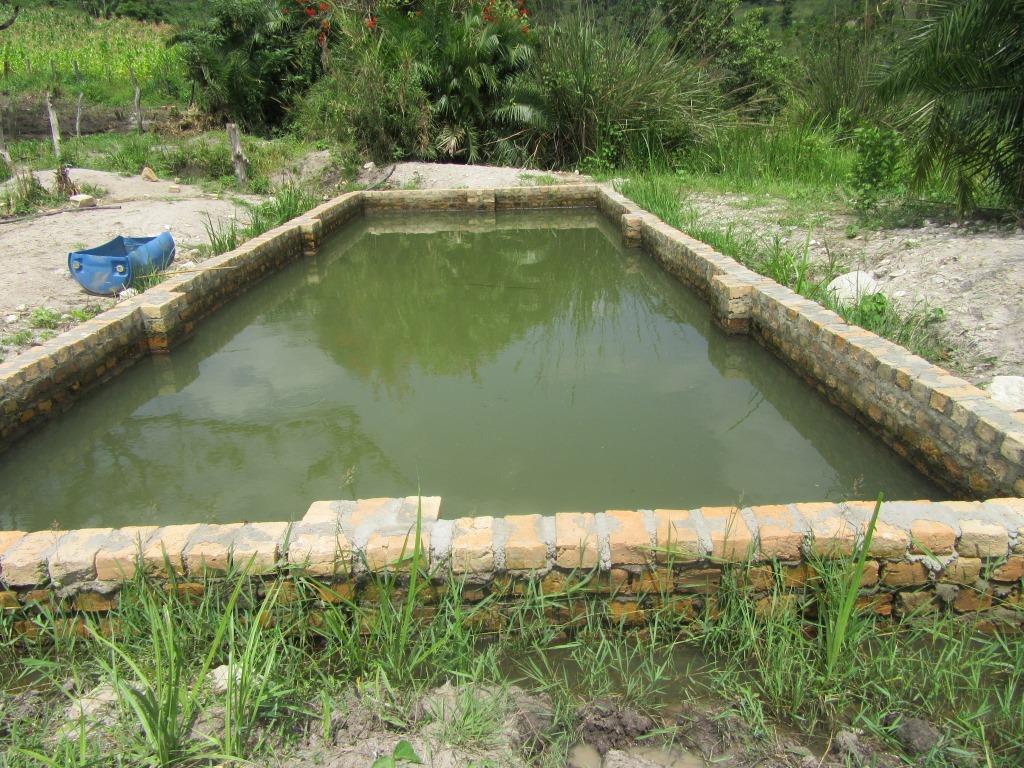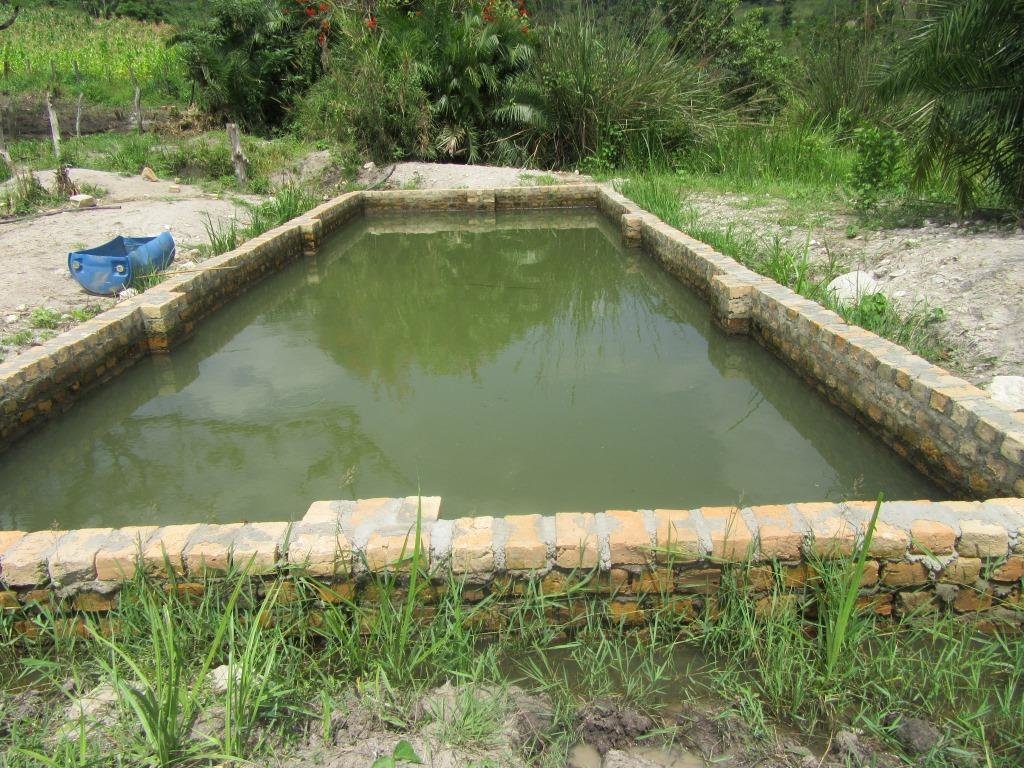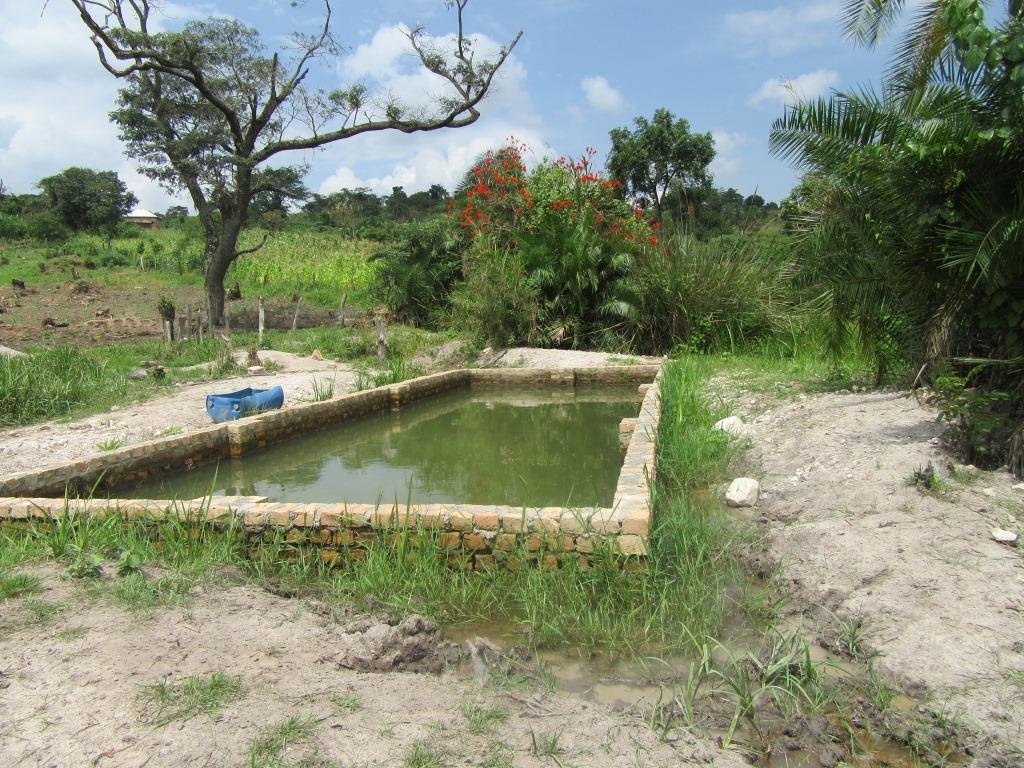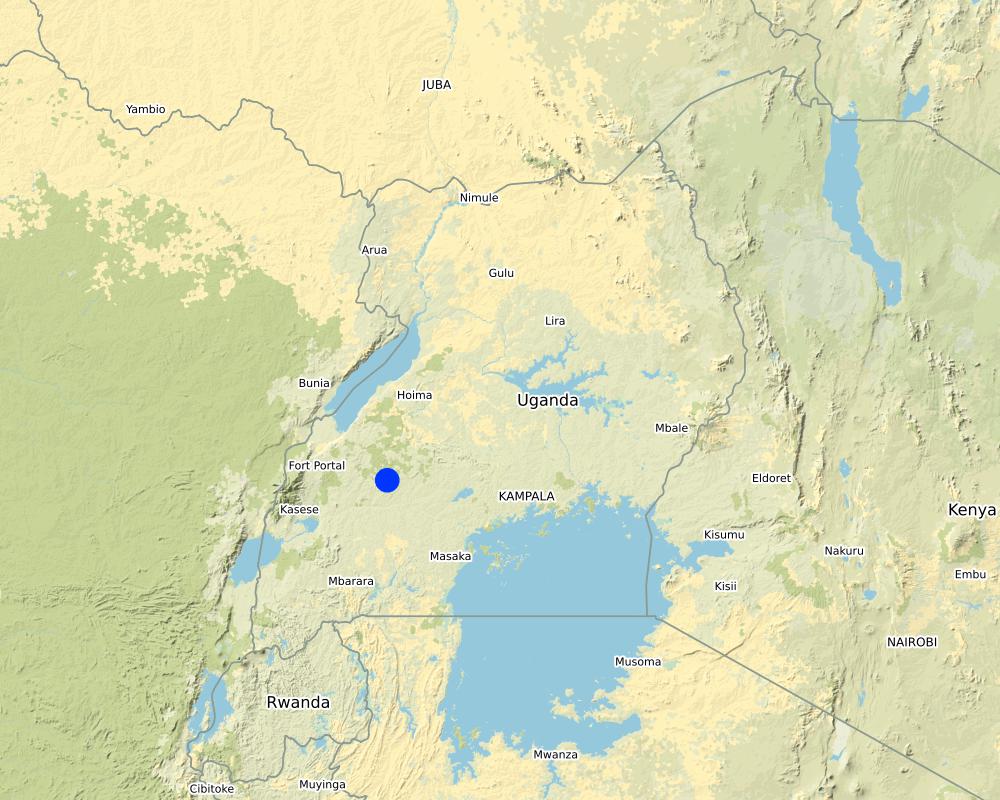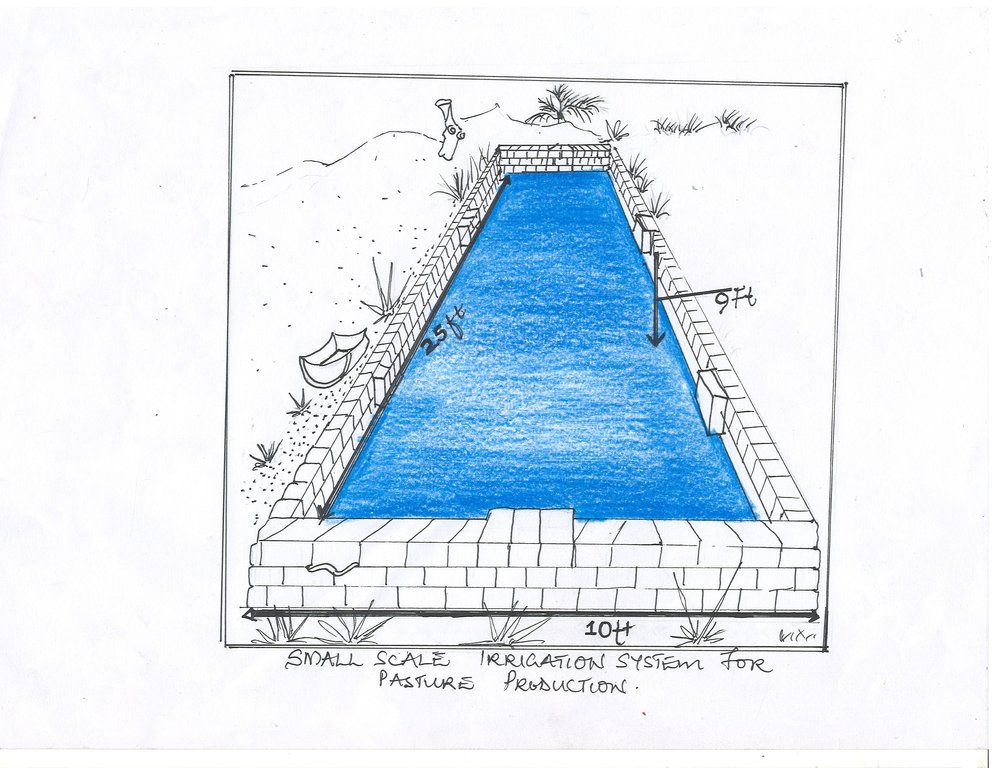Small Scale Irrigation System for Pasture Production [Uganda]
- Creation:
- Update:
- Compiler: PRISCILLA VIVIAN KYOSABA
- Editor: Kamugisha Rick Nelson
- Reviewers: Nicole Harari, Udo Höggel
Okushukerera ebinyansi byente amazzi
technologies_3434 - Uganda
View sections
Expand all Collapse all1. General information
1.2 Contact details of resource persons and institutions involved in the assessment and documentation of the Technology
Key resource person(s)
land user:
Mugisa Edward
0791465941
Uganda
Name of project which facilitated the documentation/ evaluation of the Technology (if relevant)
Scaling-up SLM practices by smallholder farmers (IFAD)Name of the institution(s) which facilitated the documentation/ evaluation of the Technology (if relevant)
National Agricultural Research Organisation (NARO) - Uganda1.3 Conditions regarding the use of data documented through WOCAT
When were the data compiled (in the field)?
22/01/2018
The compiler and key resource person(s) accept the conditions regarding the use of data documented through WOCAT:
Ja
1.4 Declaration on sustainability of the described Technology
Is the Technology described here problematic with regard to land degradation, so that it cannot be declared a sustainable land management technology?
Nee
2. Description of the SLM Technology
2.1 Short description of the Technology
Definition of the Technology:
Small scale irrigation system for pasture production. This is practiced by a farmer who effectively utilized a swamp by constructing a relatively small water reservoir for watering pastures during dry season to ensure continuous pasture production all year around.
2.2 Detailed description of the Technology
Description:
Small scale irrigation system for pasture production is the artificial supply of water to areas for agricultural use; in this case water is supplied to pasture land. It’s practiced by a cattle farmer in Kyegwemera Village Kyegegwa District in western Uganda who effectively utilized the swamp by constructing a relatively small water reservoir for watering pastures during the dry season to ensure continuous pasture production all year round.
This irrigation project was initiated and partially financed by the local government and is used as training ground for the various farmer groups interested in adoption of the technology; as technical guidance in popularizing farmer-managed smallholder irrigation systems. Also training of district staff members and other stakeholders in irrigation technology, the sustainable utilization and management of wetlands. More so, the monitoring and evaluation progress in irrigation activities in liaison with district specialists also increases development of this technology and its adoption in the district.
With support from local government, the farmer was able to construct the irrigation site to boost pasture production for his 9 dairy cattle grazed on the farm. The irrigation water reservoir has a size of 25 feet long by 10 feet wide of his total land area of 22 acres. The water reservoir has a holding capacity of approx. 25.000 liters.
This system has a small pump with the capacity of 25000 litres/h and is able to irrigate up to 5 hectares. The motorized pump is used to pump water from the swamp into an open water reservoir which is later pumped or supplied to the pastures. The water is also used for drinking for the animals.
From the irrigated fields, fodder yields are stable and reliable to meet production targets hence reduced fluctuations in year-to-year yields and reduced pasture failure during drought. With this system yields from irrigated pastures are expected to increase up to two to three (2-3) time’s higher hence increased pasture yield. In addition, irrigation enhances continuous cultivation due to available irrigation equipment like pumps and other ancillary equipment.
Establishment of the irrigation system cost two million seven hundred seventy thousand shillings only (2,770,000=); for reservoir construction labor, spade, bricks, sand, clay, fuel, servicing frequent pump breakdown, construction cement, water proof cement and generator. The system is simple to install and easy to use. The small-scale irrigation project addresses problems that have been caused by both severe and recurring drought and increasing desertification. However, majority of farmers are illiterate and lack basic knowledge of water requirements, irrigation scheduling, skills in maintaining and operating the pumps. This affects yields, as crops are either over or under-irrigated, leading to wastage of the little available water. Erosion is also a serious problem during the rainy season in addition to continuous cultivation and reduced fertility issues.
2.3 Photos of the Technology
2.4 Videos of the Technology
Comments, short description:
A video for small scale irrigation system
Date:
22/01/2018
Location:
Kyagemerwa Village, Kyegeggwa District
Name of videographer:
Aine Amon
2.5 Country/ region/ locations where the Technology has been applied and which are covered by this assessment
Country:
Uganda
Region/ State/ Province:
Western Region
Further specification of location:
Kyegegwa District
Map
×2.6 Date of implementation
Indicate year of implementation:
2016
2.7 Introduction of the Technology
Specify how the Technology was introduced:
- through projects/ external interventions
Comments (type of project, etc.):
The district local government partially funded the construction of the system to serve as a demo site for the other farmers in the area.
3. Classification of the SLM Technology
3.1 Main purpose(s) of the Technology
- improve production
- protect a watershed/ downstream areas – in combination with other Technologies
3.2 Current land use type(s) where the Technology is applied

Cropland
- Annual cropping

Mixed (crops/ grazing/ trees), incl. agroforestry
If land use has changed due to the implementation of the Technology, indicate land use before implementation of the Technology:
Grazing land
3.3 Further information about land use
Water supply for the land on which the Technology is applied:
- rainfed
3.4 SLM group to which the Technology belongs
- irrigation management (incl. water supply, drainage)
- wetland protection/ management
3.5 Spread of the Technology
Specify the spread of the Technology:
- applied at specific points/ concentrated on a small area
3.6 SLM measures comprising the Technology

vegetative measures
- V2: Grasses and perennial herbaceous plants

structural measures
- S5: Dams, pans, ponds
3.8 Prevention, reduction, or restoration of land degradation
Specify the goal of the Technology with regard to land degradation:
- not applicable
4. Technical specifications, implementation activities, inputs, and costs
4.1 Technical drawing of the Technology
4.2 Technical specifications/ explanations of technical drawing
Reservoir size is length 25 feet, width 10 feet.
Depth can be between 3 feet and 9 feet, depending on the water requirement.
Lateral gradient of structure is flat.
Space between structure and plants is 2 meters.
Capacity of the dam is approximately 25.000 liters (at 3 feet depth).
4.3 General information regarding the calculation of inputs and costs
Specify how costs and inputs were calculated:
- per Technology unit
other/ national currency (specify):
Uganda shillings
Indicate exchange rate from USD to local currency (if relevant): 1 USD =:
3650.0
Indicate average wage cost of hired labour per day:
10000
4.4 Establishment activities
| Activity | Type of measure | Timing | |
|---|---|---|---|
| 1. | Clearing the area | Management | Once |
| 2. | Pumping the water | Management | Once |
| 3. | Constructing the reservior | Structural | Once |
| 4. | Acquiring a motorized pump | Management | Once |
4.5 Costs and inputs needed for establishment
If possible, break down the costs of establishment according to the following table, specifying inputs and costs per input. If you are unable to break down the costs, give an estimation of the total costs of establishing the Technology:
2770000.0
| Specify input | Unit | Quantity | Costs per Unit | Total costs per input | % of costs borne by land users | |
|---|---|---|---|---|---|---|
| Labour | Labor | Person-days | 5.0 | 200000.0 | 1000000.0 | 50.0 |
| Equipment | Hoes | Piece | 2.0 | 10000.0 | 20000.0 | 100.0 |
| Equipment | Spade | Piece | 2.0 | 10000.0 | 20000.0 | 100.0 |
| Equipment | Motorized pump | Piece | 1.0 | 350000.0 | 350000.0 | 50.0 |
| Construction material | Bricks | Pieces | 3000.0 | 150.0 | 450000.0 | 50.0 |
| Construction material | Sand | Tone | 1.0 | 160000.0 | 160000.0 | 50.0 |
| Construction material | Clay | Tone | 1.0 | 50000.0 | 50000.0 | 100.0 |
| Construction material | Construction cement | bags | 10.0 | 32000.0 | 320000.0 | 50.0 |
| Construction material | Water proof cement | bags | 10.0 | 40000.0 | 400000.0 | 50.0 |
| Total costs for establishment of the Technology | 2770000.0 | |||||
If land user bore less than 100% of costs, indicate who covered the remaining costs:
Kyegegwa District local government
Comments:
The system was partially financed by the local government
4.6 Maintenance/ recurrent activities
| Activity | Type of measure | Timing/ frequency | |
|---|---|---|---|
| 1. | Cleaning the reservoir | Management | Daily |
| 2. | Treating the water | Management | Daily |
| 3. | Servicing the motorized pump | Management | Monthly |
| 4. | Buying fuel | Management | Daily |
Comments:
The water is cleaned to prevent blockage of the water pipes and because sometimes the farmer gives it to the cows to drink.
4.7 Costs and inputs needed for maintenance/ recurrent activities (per year)
If possible, break down the costs of maintenance according to the following table, specifying inputs and costs per input. If you are unable to break down the costs, give an estimation of the total costs of maintaining the Technology:
1246000.0
| Specify input | Unit | Quantity | Costs per Unit | Total costs per input | % of costs borne by land users | |
|---|---|---|---|---|---|---|
| Labour | Labor | Person-days | 1.0 | 1000000.0 | 1000000.0 | 100.0 |
| Equipment | Servicing motorized pump | Piece | 3.0 | 50000.0 | 150000.0 | 100.0 |
| Equipment | Fuel | Liters | 32.0 | 3000.0 | 96000.0 | 100.0 |
| Total costs for maintenance of the Technology | 1246000.0 | |||||
Comments:
Maintenance cost estimated on yearly basis
4.8 Most important factors affecting the costs
Describe the most determinate factors affecting the costs:
Labour
5. Natural and human environment
5.1 Climate
Annual rainfall
- < 250 mm
- 251-500 mm
- 501-750 mm
- 751-1,000 mm
- 1,001-1,500 mm
- 1,501-2,000 mm
- 2,001-3,000 mm
- 3,001-4,000 mm
- > 4,000 mm
Agro-climatic zone
- sub-humid
5.2 Topography
Slopes on average:
- flat (0-2%)
- gentle (3-5%)
- moderate (6-10%)
- rolling (11-15%)
- hilly (16-30%)
- steep (31-60%)
- very steep (>60%)
Landforms:
- plateau/plains
- ridges
- mountain slopes
- hill slopes
- footslopes
- valley floors
Altitudinal zone:
- 0-100 m a.s.l.
- 101-500 m a.s.l.
- 501-1,000 m a.s.l.
- 1,001-1,500 m a.s.l.
- 1,501-2,000 m a.s.l.
- 2,001-2,500 m a.s.l.
- 2,501-3,000 m a.s.l.
- 3,001-4,000 m a.s.l.
- > 4,000 m a.s.l.
Indicate if the Technology is specifically applied in:
- not relevant
5.3 Soils
Soil depth on average:
- very shallow (0-20 cm)
- shallow (21-50 cm)
- moderately deep (51-80 cm)
- deep (81-120 cm)
- very deep (> 120 cm)
Soil texture (topsoil):
- coarse/ light (sandy)
Soil texture (> 20 cm below surface):
- medium (loamy, silty)
Topsoil organic matter:
- medium (1-3%)
5.4 Water availability and quality
Ground water table:
on surface
Availability of surface water:
excess
Water quality (untreated):
poor drinking water (treatment required)
Is flooding of the area occurring?
Ja
Regularity:
episodically
5.5 Biodiversity
Species diversity:
- low
Habitat diversity:
- low
5.6 Characteristics of land users applying the Technology
Off-farm income:
- less than 10% of all income
Relative level of wealth:
- average
Individuals or groups:
- individual/ household
Level of mechanization:
- mechanized/ motorized
Gender:
- men
Age of land users:
- middle-aged
5.7 Average area of land owned or leased by land users applying the Technology
- < 0.5 ha
- 0.5-1 ha
- 1-2 ha
- 2-5 ha
- 5-15 ha
- 15-50 ha
- 50-100 ha
- 100-500 ha
- 500-1,000 ha
- 1,000-10,000 ha
- > 10,000 ha
Is this considered small-, medium- or large-scale (referring to local context)?
- medium-scale
5.8 Land ownership, land use rights, and water use rights
Land ownership:
- individual, not titled
Land use rights:
- individual
Water use rights:
- individual
5.9 Access to services and infrastructure
health:
- poor
- moderate
- good
education:
- poor
- moderate
- good
technical assistance:
- poor
- moderate
- good
employment (e.g. off-farm):
- poor
- moderate
- good
markets:
- poor
- moderate
- good
energy:
- poor
- moderate
- good
roads and transport:
- poor
- moderate
- good
drinking water and sanitation:
- poor
- moderate
- good
financial services:
- poor
- moderate
- good
6. Impacts and concluding statements
6.1 On-site impacts the Technology has shown
Socio-economic impacts
Production
animal production
Comments/ specify:
With an increase in pasture yields, this will also boost dairy production.
6.3 Exposure and sensitivity of the Technology to gradual climate change and climate-related extremes/ disasters (as perceived by land users)
Climate-related extremes (disasters)
Climatological disasters
| How does the Technology cope with it? | |
|---|---|
| drought | well |
6.4 Cost-benefit analysis
How do the benefits compare with the establishment costs (from land users’ perspective)?
Short-term returns:
very negative
Long-term returns:
slightly negative
How do the benefits compare with the maintenance/ recurrent costs (from land users' perspective)?
Short-term returns:
negative
Long-term returns:
slightly positive
6.5 Adoption of the Technology
- single cases/ experimental
Of all those who have adopted the Technology, how many have did so spontaneously, i.e. without receiving any material incentives/ payments?
- 0-10%
6.6 Adaptation
Has the Technology been modified recently to adapt to changing conditions?
Nee
6.7 Strengths/ advantages/ opportunities of the Technology
| Strengths/ advantages/ opportunities in the land user’s view |
|---|
| Continuous pasture production |
| Steady water supply all through the seasons |
| Increase in pasture yields |
| Strengths/ advantages/ opportunities in the compiler’s or other key resource person’s view |
|---|
| Quite a good innovation |
| Natural resource utilisation |
6.8 Weaknesses/ disadvantages/ risks of the Technology and ways of overcoming them
| Weaknesses/ disadvantages/ risks in the land user’s view | How can they be overcome? |
|---|---|
| Establishment is quite expensive | Government Agricultural bodies should take part in supporting farmers to help farmers establish such systems even for other crops other than pastures |
| Maintenance is relatively expensive |
| Weaknesses/ disadvantages/ risks in the compiler’s or other key resource person’s view | How can they be overcome? |
|---|---|
| Apart from the environmental risks; large-scale irrigation projects are also costly, not only in terms of capital expenditure, but also in terms of recurrent expenditures for the operation and maintenance of such systems. Such costs pose tremendous difficulties for the sustainability of irrigation schemes. Furthermore, the introduction of irrigation can also lead to inequities in the social context. | |
| Irrigation tends to increase land prices, which may lead to marginal farmers being bought out and landless tenants displaced. |
7. References and links
7.1 Methods/ sources of information
- field visits, field surveys
- interviews with land users
One (1) person in this case the land user
7.2 References to available publications
Title, author, year, ISBN:
Irrigation Techniques for Small-scale Farmers, Martin Smith, Giovanni Muñoz and Javier Sanz Alvarez, FAO 2014, ISBN 978-92-5-108326
Available from where? Costs?
Internet
7.3 Links to relevant information which is available online
Title/ description:
The Advantages of Small Scale Irrigation Schemes
URL:
http://publications.iwmi.org/pdf/H010663.pdf
Links and modules
Expand all Collapse allLinks
No links
Modules
No modules


